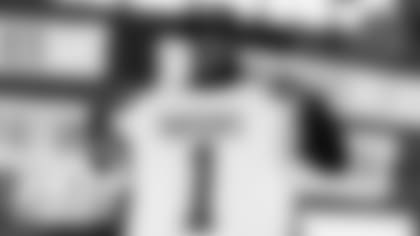FRISCO, Texas – There's an unsurprising irony in the amount we speculated about what a Mike Nolan defense might look like.
In a fitting tribute to the short-lived nature of the NFL, it turned out not to matter.
Mike Nolan oversaw exactly one defense during his time in Dallas, and now it's on to something new – and presumably much more familiar – in the hire of Dan Quinn as Mike McCarthy's next defensive coordinator.
It's too soon to call this a fix. The Cowboys suffered through a historically bad defense in 2020, and they have a lot of decisions to make between now and the start of the offseason program. Furthermore, the ongoing outbreak of COVID-19 doesn't offer any guarantees that this upcoming offseason will be any less challenging than the last one.
Still, there's plenty of reason for optimism – and that optimism can be rooted in that familiarity. Quinn is a new coach with his own set of preferences, but this is a defense that figures to look at least somewhat similar to the ones that Kris Richard and Rod Marinelli employed in 2018 and 2019. And while those defenses had their own deficiencies, they were more than serviceable – and occasionally quite good.
The purpose of this isn't to predict how exactly Quinn will employ his defense. The phrases "4-3" and "Cover 3" are going to get thrown around a lot in the coming months. And while those may be accurate, they certainly don't cover every alignment or coverage Quinn will install once he gets into a meeting room with his new defense.
Speaking of that, though, it might be possible to project how Quinn might put that group together.
For starters, as a long-time defensive line coach, Quinn already has the makings of a solid pass rush at his disposal.
One of the first things Quinn did when he took over as the head coach of the Atlanta Falcons was try to fix that problem, drafting Vic Beasley No. 8 overall to help boost a sagging pass rush. The Falcons made several more moves to address their pass rush during Quinn's tenure, finding Grady Jarrett in the fifth round of that same draft. Atlanta also famously traded in front of the Cowboys back in 2017 to draft Takkarist McKinley 26th overall.
Truth be told, neither the Beasley pick nor the McKinley pick truly worked out for Quinn. Fortunately, he might not have to worry about it in Dallas.
The Cowboys obviously already employ the bedrock of their pass rush in DeMarcus Lawrence. They also have to be excited by the progress they saw from Randy Gregory in the second half of the season – and it can't be ignored that Gregory feels like a natural fit for Quinn's LEO role, which is essentially a widely-aligned pass rusher.
Throw in the development of Neville Gallimore, along with the return of Trysten Hill from an ACL injury – not to mention the possible returns of Aldon Smith and Antwaun Woods – and there is the making of a solid defensive front.
The same can't be said for the Cowboys' secondary, which is almost entirely in flux heading into 2021. At the outset of his tenure, that might be the most logical way for Quinn to put his imprint on this team.
As it sits right now, three of the team's most experienced defensive backs – Chidobe Awuzie, Jourdan Lewis and Xavier Woods – are set to become free agents, leaving plenty of holes in the depth chart.
The Cowboys did spend the No. 51 overall pick on Trevon Diggs last year, and he figures to be a quality starter in almost any scheme imaginable. It's also hard not to be encouraged by what Donovan Wilson showed over the second half of his rookie season.
This is where Quinn's history is especially intriguing. He got the head coaching job in Atlanta off the incredible success of those Seattle defenses, which were famous for featuring tall, long corners, an instinctive free safety in Earl Thomas who could handle single-high assignments and a punishing strong safety in Kam Chancellor who excelled against the run and wasn't a liability in coverage.
Even during his time in Atlanta, Quinn seemed to be looking to replicate some of that success. The Falcons spent several big draft picks on cornerbacks such as Jalen Collins, Isaiah Oliver and A.J. Terrell – all of whom measure up at 6'0 or taller, and all of whom have 31-to-33-inch arms.
He also clearly values the safety position a bit more than the Cowboys have historically, as he spent the No. 17 overall pick on Keanu Neal back in 2016. If we're forcing ourselves into player comparisons, Neal fit more closely into Chancellor's role than Thomas' – but he was quite good at it. He made the NFL's all-rookie team in 2016 and the Pro Bowl in 2017 before injuries derailed his 2018 and 2019 season. Healthy and available for 15 games this season, Neal finished with 100 tackles, a sack and two takeaways.
Neal is an impending free agent, coincidentally enough. And obviously, Thomas himself was unemployed throughout the 2020 season – a fact that is sure to be mentioned now that his former defensive coordinator works in Dallas.
It's anyone's guess what this means right now. The Cowboys are not traditionally big spenders in free agency, and that likely figures to be the case again in 2021. But they will add talent that offers an idea of what they have in mind – same as Nolan and McCarthy did last year.
Still, it's interesting to think that the Cowboys could have as many as 10 draft picks to work with this spring, and several of them will be used to help Quinn mold the defense in his image.
He could go a long way toward doing that even in Year 1 – particularly within this Dallas secondary.















